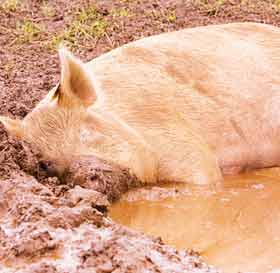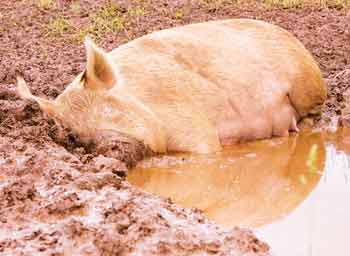Act now to minimise pig stress

Appetite depression, loss of production and fertility problems are all associated with heat-stressed pigs, but planning now could help prevent losses this summer.
And according to BPEX knowledge transfer manager Helen Thoday, the unpredictability of UK weather means producers must have practical methods of reducing heat stress.
“Having materials ready, such as canvas sheeting for shading and ready-made wallows, to meet the pig’s needs during hot weeks is important. Also, positioning arcs in prevailing winds to maximise airflow and painting arcs white can reduce the temperature inside by up to 7C. But it is important to use your eyes and look at the pigs’ behaviour as this will tell you how comfortable they are,” she says.
 |
|---|
| Create ready-made wallows to minimise heat stress over the summer. |
“During the first 30 days of pregnancy, if a pig becomes heat-stressed, blood is diverted to the skin and away from the unborn piglet, making absorption more likely, leading to a higher return rate.”
Keeping boars’ testicles cool is equally important, according to pig vet David Chennells. “Temperatures above 24C will see pigs getting stressed and boars in extreme heat stress could have reduced semen quality. As it takes eight weeks for sperm to be produced, boars could potentially be sub-fertile or infertile for most of the summer. Temperature of semen used during AI should also be kept between 16 and 18C,” he says.
Rearranging the day so service takes place early on is also something Mr Chennells recommends. “If trying to serve at the hottest part of the day, not only are the animals too hot, but operators can have lower concentration levels leading to more mistakes. And even when conception is successful, a farrowing house that is too warm can delay farrowing and is a trigger factor for masititis, metritis and agalactia (MMA).”
Weaning weights will also be affected when the farrowing house becomes too hot, says pig technologist Mark Hawe. “When sows are too hot, their feed intake will reduce, so too will production, which will ultimately affect piglet weaning weight. Also, sows will milk off their back, which could increase the weaning-to-service interval. Adequate fresh drinking water for all stages is needed to keep pigs cool.”
Good ventilation is also needed to keep ambient temperature down, but having a good system doesn’t have to be expensive, says Mr Chennells.
“Temporarily removing panels from buildings and opening out ridges can increase airflow through buildings, but this must be done now before it gets too hot. Checking ventilation systems are working is also important as more than 90% of system failures occur because they are clogged with dirt. Now is the ideal time to clean them as doors and windows can be left open while cleaning takes place.”
Thinking about reducing stocking densities or selling pigs lighter to avoid overcrowding can reduce heat produced in a building. “Being too hot is the biggest trigger factor for reduced feed intake, resulting in a decline in growth rate and an extended finishing period.”
